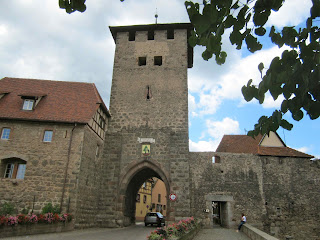We really feel we’re in an amazing Tyrolean village! The buildings within the walls of this medieval town are amazing. They represent a number of different historical periods, half-timbered houses of the Middle Ages, stone edifices of the Renaissance (Peasant War) and 17th century homes rebuilt after the Thirty Years War as well as numerous large cellars representing the flourishing wine trade of the 18th century.
The narrow building on the right reveals the shortage
of space within the city at the time.
Old and beautiful
Dambach was a consolidation of smaller villages in the area and became a fortified Episcopal city in the 14th century by the Bishop of Strasbourg to help protect the inhabitants.
The city gates were built in 1323.
We had a lovely meal last night, despite some language difficulties we managed to order two great dishes, one a slow cooked pork shin, the other a loaf of mixed meats – sounds funny but tasted great. But the best part of all was the local Grand Cru Riesling – quite a treat!
A great local Grand Cru Riesling
This morning we had a two hour walk up quite a steep mountain behind the village to the ruins of Bernstein Castle, a 12th century granite palace with rare Romanesque windows. It was conquered in 1277 by the Bishop of Strasbourg who already occupied the city.
The Saint Sebastian Chapel, on the way, is the former parish church of an abandoned village just above Dambach. The altar is quite unusual and was carved in 1690 from linden and pear woods.
The city is surrounded by over 450ha of vineyards, 45 of which are ‘Grand Cru Frankstein’ and there are a number of cellars around town still operating today as they have done for centuries.
Ripening Riesling
Who said it doesn’t get cold in winter!








The view from that vineyard is alright, isn't it? What a lovely photo of Mum!
ReplyDelete